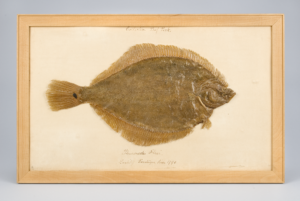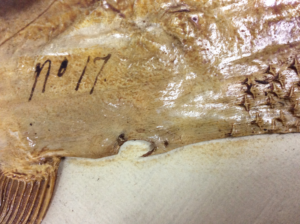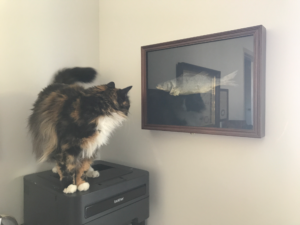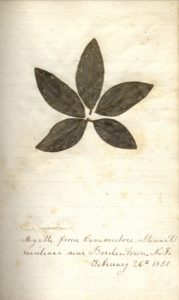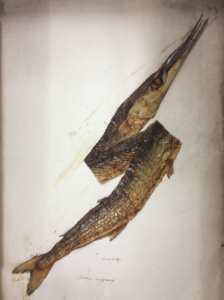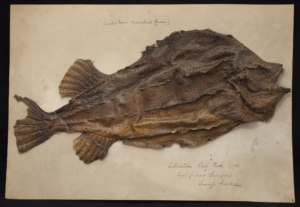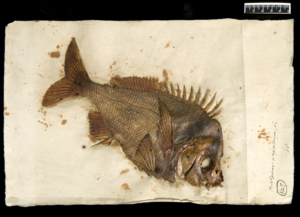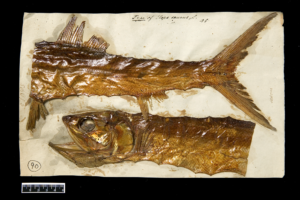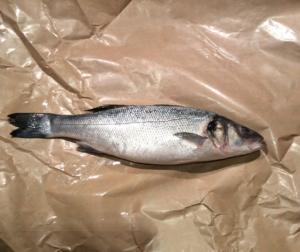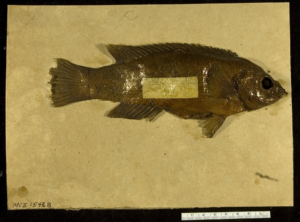The dried skin of a fish hangs over my head as I type. It has been there for nearly two years, and no longer smells as it did for weeks after I slit the animal in half (fig. 1). This sea bass from the grocery store, now a specimen, was my attempt to understand a widespread but little-remembered practice in eighteenth-century science that might seem strange to us today: to dry, bisect, and flatten animals like fish, and then glue or stitch them on paper or slip them in books like pressed flowers (fig. 2).
In the 1740s, a Dutch botanist named John Frederick Gronovius published a set of fish flattening instructions in the Philosophical Transactions of London’s premier scientific collective, the Royal Society. Many more naturalists would publish variant recipes. According to Gronovius, one would cut the animal in half from head to tail with “Scissars,” remove its innards and flesh, keep the tail and fins expanded with pins while the fish dried in the sun or near a fire, and press the skin for a full twenty-four hours. When American naturalist John Bartram opened a package with one such sample, he matter-of-factly told Gronovius, “I have received . . . the skin of the Fish, with its fins curiously displayed on paper; all which was very acceptable.” Naturalists from America, England, Portugal, France, the Netherlands, and elsewhere would exchange hundreds—more likely thousands—of similar specimens across the world in that century.
Resembling drawings or engravings more than live animals, these objects gave naturalists a literal demonstration of their favorite metaphor: that science was an act of reading the “book” or “page” of nature, written by God, the ultimate author. The half-skins also served more practical ends by facilitating colonial expansion and the creation of universal taxonomies, or systems for arranging nature. One could ship paper fish around the world in essentially picture form, stacked in a box where they took up “very little more room than a Drawing,” and looked “infinitely better,” in the words of London-based collector George Humphrey. Each fish became fused with metadata and annotations written on its paper background or on the skin itself (fig. 3). As a form of early modern information management, this fish paperwork made the animals of the far reaches of an empire visible and readily accessible to those seeking to exploit them. Flattened fish were not merely objects to be shipped efficiently: they were surfaces for storing knowledge.
In some ways, my own fish seems an inadequate window into this history. Period instructions stressed the “facility” of this technique, the “most simple” method for preserving fish, in which the animal’s skin “may be slid off almost like a glove,” to use their terms. My experiment, which involved an hour of indelicate hacking at fish flesh, proved a stickier venture. Most specimens I have observed are thinner than cardstock and astoundingly flat, and some are flush with the paper, with barely a bubble, ripple, or ridge. Mine, however, continues to curve back to its living form, while its crunchiness (also evident in a large crack) prevents me from fully flattening it after the fact. Caretaking has produced its own anxieties, as I kept my specimen atop my tallest bookshelf and away from a curious cat for months, but as a result, dropped it from six feet in the air when collecting it for reexamination, and lost a pelvic fin in the process. For easier retrieval, transport, and long-term storage, I opted to keep the fish in a shadow box designed for war medals instead of on paper (fig. 4).
Then again, everything seemingly wrong about this fish also underscores the improvisational nature of natural history in early America. Especially in colonial settings or budding republics, where many of these animals were first collected, people had to make use of the materials available to them. They flattened fish on the fly—which at times might mean borrowing prep materials from the kitchen, or making a fish into a much-needed meal instead of an artifact in a far-off scientist’s cabinet. What’s more, naturalists’ breezy assurances about the ease of the flattening process actually erase the craft, as well as the often-unfree labor, that produced these artifacts. Flattening animals on bare sheets of paper squeezed out rich social and environmental contexts behind such specimens, promoting a particular politics of seeing and making.
Flattened Animals in Early America
The naturalists who flattened fish on paper were typically botanists, first and foremost. They transferred the methods of their home discipline to new subjects, drying and flattening not only fish on paper, but also a range of other creatures—from snakes to butterflies—often with the aid of a botanical press. Gronovius told Bartram that he sent “dryed fishes, to be kept as plants in an Herbarius,” or herbarium—a collection of dried plants varnished, glued, or sewn on sheets, often stored within bound books on library shelves (fig. 5). Herbarium collections, made by actors as wide-ranging as elite male naturalists in scientific institutions to women who pressed plants in albums at home, consciously riffed on the metaphor of nature as a book or text. As a result, some call the objects I examine here “fish herbaria.”
Most fish herbarium specimens reside in Europe today. In basements and boxes and vaults there, I’ve seen the obstinate skins of armored catfish, the top halves of stingrays, a collapsed pufferfish, shoeleather shark skins, and lengthy garfish and eels folded over themselves to fit on paper; fish with giant spined sails that could pierce skin, and others no larger than a thumbprint; specimens strapped in place with a network of strings, fragile seahorses secured with pins, and many more hastily varnished onto the page, as if to become one with it (fig. 6). One significant collection remained in North America: that of the naturalist William Dandridge Peck. After graduating from Harvard in 1782 and a brief stint in a counting house, Peck apparently learned how to prepare specimens on his own as he lived and farmed with his reclusive father in Kittery, Maine, possibly with Gronovius’s recipe at hand. He assembled most of this collection of fish skins in the 1790s, before working as a professor of natural history at Harvard and curator of its botanical garden from 1805 until his death in 1822.
Several dozen animals remain in Peck’s collection at Harvard today, spread across the Museum of Comparative Zoology and the Collection of Historical Scientific Instruments. The skin of a flounder—a naturally flat fish, with two eyes on its upward-facing side—seems readymade for the page (fig. 2). Peck’s once-bulbous and once-colorful lumpfish (fig. 7), on the other hand, underwent severe transformations to fit on paper (fig. 8). While any translation from three to two dimensions results in some form of loss or distortion (see, for instance, the Mercator projection of our globe), certain creatures accommodated flattened preservation much better than others. So too, larger species like sharks would only fit on the page in juvenile form. All such specimens threatened to turn a dull brown with time, and to break down by virtue of their very mode of preservation: they were so dry that they became brittle. Peck warned students as he displayed one in a lecture: “The scales are very loosely attached, & fall with a touch tho even so gently handled.”
Flattening a fish may have warped some of the animal’s features, but it actually helped conserve the ones that mattered most to many naturalists. Peck offered a course of natural history lectures at Harvard, where he leaned heavily on the methods of the Swedish naturalist Carl Linnaeus, seen as the father of modern biological nomenclature. Instead of salvaging the whole fish in a bottle of rum or styling it to appear lifelike, Peck preserved and highlighted particular surface features needed for sorting the animals according to Linnaeus’s system, and for teaching this system to students. Numerous observers remarked that this method of preservation allowed one to easily count the number of rays or spines within each fin of a specimen—the fins Bartram found so “curiously displayed”—and this quantitative move was, and remains, one of the hallmarks of fish classification. Gronovius’s recommendation to spread the fins with pins as the animal dried ensured those features remained countable in the fish’s afterlife.
These specimens, however, reveal a world far larger than the elite circles of Linnaeus, or even the modest Peck. Flattened knowledge depended on people and other animals on the outskirts of empire, and multiple human groups and practices left imprints on the specimens.
The Concealed Labor of Flattening
Peck seldom mentioned these fish specimens in his letters and lecture notes. We do know, however, that he used a range of people to gather specimens for him, including local anglers and even children. Naturalists routinely sent others to collect on their behalf. Alexander Garden, a Scottish physician and aspiring botanist based in Charleston, South Carolina, who supplied Linnaeus with numerous fish half-skins, explained in a 1771 letter to the Swede:
…I sent a black servant last summer to the island of Providence. During his stay there, he collected and preserved some fishes amongst other things; but, meeting with tempestuous weather in his return, and being, for several days together, in dread of immediate shipwreck, he neglected all his specimens, many of which perished. Some were fit only to be thrown away, and others were greatly damaged. What remain, such as they are, I shall, by this opportunity, send for your examination. Some fishes among them, whether found in our sea, or in that of the Bahama islands, you may perhaps find to be new.
This unnamed “black servant” was likely enslaved, given that Garden owned slaves and encountered and treated many more while working as a physician in Charleston. Garden offered this anecdote, and individual, as a buffer to explain why he sent Linnaeus a mere fourteen specimens in his shipment. He underscored their “neglect” due to environmental hazards faced by the man—hazards from which Garden remained immune. Garden’s accusatory move to preserve his own credibility unintentionally offers a means of tracking how he obtained his specimens. Some of the half-skins preserved by this individual on the 1771 collecting trip are housed today at the Linnean Society of London, including a trumpetfish and porkfish; numbers written on their skins allow us to correlate mute fish with anonymous collector (fig. 9). Despite Garden’s disparaging remarks, the specimens outlasted many others from the period—a testament to this man’s skill and the permanence of his labor, which underwrote a foundational collection in the history of science. How many unrecorded collecting trips might he have made on Garden’s behalf?
In addition to marginalized people, extra-scientific practices also left their mark on these specimens. Perhaps the most important role fish played in early American life was at the dinner table. Once fish began their journeys toward becoming scientific specimens, their status as alimentary objects continued to leave traces. A flattened type specimen of the ladyfish held in a vault at the Linnean Society offers one peculiar culinary story (fig. 10). While the notion of a type specimen did not yet exist in the eighteenth century, many of Linnaeus’s fish have been retroactively classified as such, being the selfsame specimens used to generate the first Western, published descriptions of the species. Type specimens are, paradoxically, “concrete abstractions,” in the words of historian of science Lorraine Daston—presenting some ironies when a fish turns out to be an unrepresentative representative of the species. Garden told Linnaeus that the ladyfish he sent was “the only specimen of this fish that I ever saw, and the gentleman who was kind enough to let me have it, had unluckily ordered it to be dressed for supper, so that the scales were taken off before he thought of me; and hence you will observe that I could not see the natural appearance of the fish, nor make the characters complete.” Though scales were and remain a quantifiable trait important to ichthyologists, the almost-fried fish still secured its spot in the hall of biological fame. Split into chunks and especially shiny, this specimen embodies a seemingly unscientific relationship between humans and fish that nonetheless left its mark on a natural history repository.
The reverse, however, was also true: many specimens never made it into academic collections precisely because they were potential foodstuff. Garden lost fish specimens to animals and people, as when he griped to Linnaeus about a certain rockfish: “I never had but only one to examine, and the company who permitted me to make out the description, insisted on their having the pleasure of eating it, otherwise I would have preserved the specimen for you.” Some of the tastiest animals probably never made it to the page. At times, naturalists even consumed their own specimens, in whole or in part, effectively incorporating their objects of study into their own bodies.
Hungry insects frequently descended on scientific archives as well. As a result, overseeing collections involved not only the more dramatic events of describing new species and ordering the natural world, but also ordinary—sometimes extraordinary—acts of maintenance and care. In 1795, the Massachusetts Historical Society printed tips, supplied by Peck, for protecting collections of animals from insects, which included regular handling and inspection of objects, as well as lying in wait past twilight for nocturnal pests.
How to Cut and Paste, Eighteenth-Century Style
At their most basic level, gathering fish, making specimens, and maintaining collections required intimate bodily interactions with nonhumans. Historians of science such as Pamela Smith and Otto Sibum have explored how certain physical practices cannot be conveyed in words, as historical hands and bodies possessed “tacit knowledge” that does not translate into linguistic form. Says philosopher Michael Polanyi: “we can know more than we can tell.” Since embodied knowledge differed fundamentally from written knowledge, recovering it would require distinct methods of investigation. And so, one way to understand historical making is by doing.
All of which led to my day with the fish (fig. 11). During the Obama years, I went to the grocery store, asked a skeptical fishmonger which species might be simplest to cut in half and flatten, and at his recommendation of a European sea bass, or branzino, chose one small enough to fit on a sheet of butcher paper. With a printout of Gronovius by my side, I brought the fish to a kitchen. After bisecting its body with scissors, splitting the head in two with a chef’s knife, and tediously removing organs, flesh, bones, gills, and wet membrane, I spread what was left on a board with the fins expanded with pins, as Gronovius instructed (fig. 12). Trying not to alarm my neighbors, I opted to dry it in the oven rather than outdoors, knowing early American naturalists like Manasseh Cutler suggested preserving animals between sheets of paper in the oven “after the bread is drawn.”
Soon—and perhaps no thanks to my modern oven—I realized the difficulty of keeping the animal flat. As a result, I have a better grasp of the extended presence of the naturalist, or a helper, or some sort of press after cutting, as well as a fuller sense, by extension, of the value placed on flatness. Some versions of instructions stress customizability, as when English physician John Coakley Lettsom, who supplied Harvard’s early collections with specimens, wrote: “the two sides of [the fish’s] skin may…be dried upon paper like a plant, or one of the sides may be filled with plaster of Paris, to give the subject a due plumpness.” Room for improvisation would have been critical in colonial or early republic contexts, as local institutions like the Massachusetts Historical Society encouraged preparing specimens with materials from one’s own pantry, such as black pepper and egg yolks. Despite some room for variation in technique, however, the deliberate flatness I have witnessed in the vast majority of specimens seems all the more remarkable and coerced having tried my own hand at the process and wrestled with a fish body hell-bent on curling back to three dimensions.
Early modern caretakers must have constantly attended to these stubborn materials through vigilance and persistent pressing. It is hard to appreciate how protracted this process was from two pages of sparse instructions, though Gronovius did intimate the constant management of the specimen when he cautioned: “as a sort of glutinous Matter, in pressing, is always forced out from betwixt the Scales and the Skin, a Piece of Parchment is to be laid under the Fish, which is easily separated from the scales, but Paper always sticks: For this Reason it is necessary, that after an Hour or two, a fresh Piece of Parchment should be applied.” In Gronovius’s experience, and now mine, the fish continued to assert its sticky (and, frankly, stinky) existence.
In preparing the fish, I also began to understand the risk and apprehension that attended specimen creation and care: scissors and knives and pins can slip and injure the specimen or one’s hand, and fish bones are as sharp as scissors, as cookbooks often warned. I escaped with just one injury. This was also an irreversible process: early modern naturalists had to carve up what was often the only specimen of that species they would see in their lifetimes—and, in some cases, an animal entirely new to European science. They had one chance to bisect a creature correctly. Then again, naturalists and the many people who prepared these specimens no doubt accumulated experience from cutting and flattening many fish over time. I hope to follow in step by replicating this procedure with more specimens in the future.
Standing in a kitchen with a knife in one hand and a store-bought fish in the other, I also began to ask a new set of questions: Would someone in the eighteenth century fillet a fish the same way I do? Would she eat it with the skin on? Was cooking the model, implicitly or explicitly, for creating these specimens? What were the gender implications of this food-made-flatness, given that natural science was often (though not always) closed to women at this time, yet women—especially women of color—did much of the cooking and would have intimate knowledge of fish interiors? Understanding how fish were prepared for supper and cooked as meals might also indicate what precedents or tacit knowledge the creators of fish herbaria drew upon as they slit animals in half and placed them on paper—paper that must have, to some, resembled a book plate, and to others, a dinner plate.
These questions sent me back to historical cookbooks, opening my eyes to how angling and cooking might themselves be considered modes of natural historical practice and connoisseurship, and how their status as such can help us understand the unwritten models behind the creation of scientific objects. Fishing required intimate knowledge of species-specific fish habitats, behavior, and development, while preparing fish as food involved collecting, identifying, drying, and preserving animals—all tools in the naturalist’s repertoire.
Maria Eliza Rundell’s A New System of Domestic Cookery, first printed in Britain in 1806, and in America in 1807, described numerous techniques similar to the ones I performed, such as: “After scaling and cleaning, split the salmon.” The shared maneuver of bisecting fish for alimentary and scientific purposes required analogous mastery of fish bodies, though that anatomical expertise would ultimately serve different purposes. Glimpses of kitchen techniques crept into the books of naturalists from time to time, too: William Swainson noted that “Lampreys, eels, and other cylindrical fish may be preserved by skinning them from the head to the tail, in the same manner as eels are prepared for cooking.” Natural history is also the history of food, and food history a form of natural history.
Cookbooks also make clear how class and race may have informed the conversion of fish into specimens and meals, resulting in the (erroneous) appraisal of both as unskilled productions. In a word, cutting fish in half is gross. As such, it was historically often relegated to laborers who were lower on the social hierarchy. In A Practical Treatise on the Choice and Cookery of Fish (1854), William Hughes wrote disparagingly that “[t]he cleaning of fish is a very important matter, but, being a disagreeable office, is often entrusted to unskilful hands, who execute their task so negligently, that almost as many fish are injured by this process as by bad cookery.” Once more, Hughes also inserted fish bisecting instructions that resemble Gronovius’s process, noting: “Fishes that require to be opened by the back…should be split through from nose to tail with a very sharp knife, so that the flesh may be cut clean and without being jagged close to the back bone.”
Yet, my reenactment was also an exercise in not knowing. Fish flattening instructions lacked numerous steps—such as how to prepare the eyes, which I guessed on my own—and many of the bodily gestures don’t translate into writing. This presents somewhat of a dilemma for the historian: after performing this process, I’m fully convinced that one needs to replicate historical recipes in order to understand them. At the same time, we could never duplicate the social context of producing these in the eighteenth century, let alone the power structures that governed their making.
Perhaps the loss of knowledge is the point: flattening, as suggested by my reconstruction, largely erases traces of labor, even as it embodies artifice. The final product seems simple and self-evident. Instructions depict cutting and flattening as unskilled acts, even though getting them right required dexterity and mastery of various craft techniques, not unlike that needed for sculpted taxidermy. Instructions promised an easy process, but it was often anything but, being carried out in the bonds of slavery, amidst literal tempests. Reassuring, can-do recipes had a political edge that persisted in the final product, as flattening sutured these animals to paper bearing Latin, not indigenous, names, with nary a mention of the original encounter between collector and collected fish. Even so, those larger histories remain congealed in the specimens.
Flattening in the Here and Now
Eighteenth-century ichthyologists loved to bemoan the neglect of their discipline. Peck’s own specimens were reportedly misplaced at Harvard for many decades. In the 1930s, Thomas Barbour, then the director of Harvard’s Museum of Comparative Zoology, tried to write a biography of Peck for many years. He gave up, insisting the story “would not pull into a yarn.” Barbour described the fish prepared by Peck as “mounted after the crude manner of the day,” and elsewhere echoed eighteenth-century instructions when noting Peck “was drying out and pressing fish skins and sticking them on cards, making very crude reference specimens.” He concluded that Peck was “a dreary, tiresome letter writer” and that most of his life story was “fragmentary” and “absolutely without any human interest”—even if Peck was “an awfully good naturalist.” Faded and pungent, Peck’s fish aren’t nearly as sexy as towering dinosaur bones or flashy bird feathers (fig. 13). Peck has largely fallen into obscurity, though he published America’s first article on systematic zoology (on fish). Nevertheless, fish flattening appears to be having a moment. After generating my own specimen, I learned I was not the only researcher in the world with a taste for flat fish: a group of scholars at the University of Leiden also recently replicated the Gronovius technique as part of a larger project on the history of ichthyology, as did a wholly separate group in Portugal after discovering a cache of long-lost flattened specimens at the University of Coimbra. Both teams of reenactors (which happened to include scientists), like most of my literate historical actors, stressed the accessibility of the technique given the low-tech tools involved, though their documentation of the process speaks to the uncertainties and gore along the way.
Why have so many turned to flattened fish now? I don’t have the answers. Curiosities then, and still curious now, the specimens are quite simply wonderful and strange. I first began my research after staring in confusion at a dried pickerel from Peck’s collection hanging on a wall in Harvard’s Collection of Historical Scientific Instruments. The resurgence of fish flattening might be tied to do-it-yourself culture, the so-called maker movement, and a recent materialist turn in academia. But I think it runs deeper than that. These specimens continue to speak to us because they still have more to say. As Gronovius said: “Paper always sticks.”
Acknowledgments
This research was supported in part by fellowships from the American Antiquarian Society, the Consortium for History of Science, Technology and Medicine, the William L. Clements Library at the University of Michigan, and Harvard University’s Graduate School of Arts and Sciences and the Jens Aubrey Westengard Fund. Sincere thanks are due to the American Antiquarian Society, the Linnean Society of London, the Natural History Museum, London, and Harvard University’s Museum of Comparative Zoology and Collection of Historical Scientific Instruments for their generosity in granting image permissions free of charge. I am grateful to staff at a number of libraries and archives for their help during my research, including the American Antiquarian Society (especially Nan Wolverton and Jackie Penny), the Harvard University Archives, the Collection of Historical Scientific Instruments, the Academy of Natural Sciences of Drexel University, the Massachusetts Historical Society, and the Royal Society of London. Particular thanks go to Karsten E. Hartel at the Museum of Comparative Zoology, James Maclaine at the Natural History Museum, London, and Lynda Brooks at the Linnean Society of London for their help navigating fish collections and answering many a question about ichthyology. This piece benefited from feedback from fellow panelists and audience members after a talk at the History of Science Society meeting in Toronto, as well as from students and teaching staff when I presented it as a guest lecture for Laurel Thatcher Ulrich’s and Sara J. Schechner’s “Tangible Things” course at Harvard. Ethan W. Lasser and Jennifer L. Roberts have provided invaluable insights on fish flattening since the inception of this project, and I am also grateful to Joyce E. Chaplin, Harriet Ritvo, Carla Cevasco, Zachary Nowak, Chloe Chapin, and Grace Kim for reading versions of my fish flattening reconstruction and for graciously offering comments. Ellery Foutch and Sarah Anne Carter provided sage edits, and Kathy Foley expertly shepherded the piece through the production process. I am especially thankful to Zachary Rotholz, who helped me select a fish and strategize about the cutting process, to William Robles for allowing me to keep the fish in a putrefied state in our apartment for several weeks before we varnished it, and to the fish itself, whose body will live on.
Further Reading
The history of natural history in early America and the early modern world is a rich field of study. See in particular Susan Scott Parrish, American Curiosity: Cultures of Natural History in the Colonial British Atlantic World (Chapel Hill, 2006); Andrew J. Lewis, A Democracy of Facts: Natural History in the Early Republic (Philadelphia, 2011); Stuffing Birds, Pressing Plants, Shaping Knowledge: Natural History in North America, 1730-1860, ed. Sue Ann Prince (Philadelphia, 2003); Sara Gronim, Everyday Nature: Knowledge of the Natural World in Colonial New York (New Brunswick, 2009); and D. Graham Burnett, Trying Leviathan: The Nineteenth-Century New York Court Case That Put the Whale on Trial and Challenged the Order of Nature (Princeton, 2007). On type specimens in particular, see Lorraine Daston, “Type Specimens and Scientific Memory,” Critical Inquiry 31:1 (Autumn 2004).
On ties between natural history and Atlantic slavery in particular, see Christopher P. Iannini, Fatal Revolutions: Natural History, West Indian Slavery, and the Routes of American Literature (Chapel Hill, 2012); Kathleen S. Murphy, “Translating the Vernacular: Indigenous and African Knowledge in the Eighteenth-Century British Atlantic,” Atlantic Studies 8:1 (2011); and James Delbourgo, “Divers Things: Collecting the World under Water,” History of Science 49:163 (June 2011). On early American visual and material culture in relation to natural history, see Ann Blum, Picturing Nature: American Nineteenth-Century Zoological Illustration (Princeton, 1993) and Michael Gaudio, “Swallowing the Evidence: William Bartram and the Limits of Enlightenment,” Winterthur Portfolio 36:1 (2001). On the role of “invisible technicians” in knowledge production, see Steven Shapin, “The Invisible Technician,” American Scientist 77:6 (1989).
Little has been written about William Dandridge Peck. For brief biographical sketches, see Jeannette E. Graustein, “Harvard’s Only Massachusetts Professor of Natural History,” Harvard Alumni Bulletin (1958) and I. Bernard Cohen, Some Early Tools of American Science: An Account of the Early Scientific Instruments and Mineralogical and Biological Collections in Harvard University (Cambridge, Mass., 1950). On education and collections at Harvard in the late eighteenth and early nineteenth century, see The Philosophy Chamber: Art and Science in Harvard’s Teaching Cabinet, 1766–1820, ed. Ethan W. Lasser (Cambridge, Mass., 2017). Peck’s personal papers are spread across a number of institutions, but most reside in the Harvard University Archives (HUG 1677).
Several scholars in a number of fields have incorporated making and tacit knowledge into their research (or ruminated on the difficulties of doing so). See, for example, Pamela H. Smith, “In the Workshop of History: Making, Writing, and Meaning,” West 86th 19:1 (2012); H. Otto Sibum, “Reworking the Mechanical Value of Heat: Instruments of Precision and Gestures of Accuracy in Early Victorian England,” Studies in History and Philosophy of Science 26:1 (1995); and James Elkins, “Why Art Historians Should Learn to Draw and Paint,” (1994–present). For a foundational text on unwritten and unspoken knowledge, see Michael Polanyi, “Tacit Knowing,” in The Tacit Dimension (Chicago, 1996).
Flattening, too, has gained traction as a problem and concept in a number of fields. See B.W. Higman, Flatness (London, 2017); Staffan Müller-Wille and Isabelle Charmantier, “Natural History and Information Overload: The Case of Linnaeus,” Studies in History and Philosophy of Science Part C: Studies in History and Philosophy of Biological and Biomedical Sciences 43:1 (March 2012); Matthew C. Hunter, “Knives Out: Thinking On, With, Through, and Against Paper in the Mid-1660s,” in Wicked Intelligence: Visual Art and the Science of Experiment in Restoration London (Chicago and London, 2013); and Bruno Latour, “How to Keep the Social Flat,” in Reassembling the Social: An Introduction to Actor-Network Theory (Oxford, 2005).
This article originally appeared in issue 18.1 (Winter, 2018).
Whitney Barlow Robles is a PhD candidate in American Studies at Harvard University writing a dissertation on the formative role nonhuman animals and specimens played in eighteenth-century natural history. Her most recent publications include an essay about a 1755 earthquake that shook Boston, published in The New England Quarterly, and a chapter about flattened scientific specimens in the book The Philosophy Chamber: Art and Science in Harvard’s Teaching Cabinet, 1766-1820.




